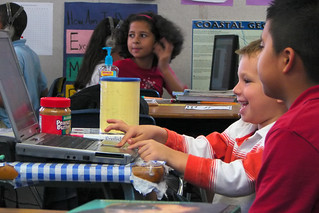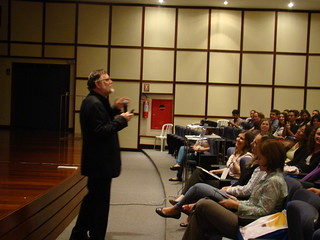I really believe in the importance of bonding with the students, so I prefer ice-breakers that involve the exchange of personal information. Two "oldies" that my students always enjoy are:
The best lie: Write four sentences on the board about you. It can be general information or specific, such as what you did on your last vacation. Among the four sentences, one has to be wrong. Lie as best as you can! Students have to talk in pairs and identify the wrong sentence. Then it's their turn: they write their own sentences, one of them being wrong, and their classmate has to spot the lie. Finally, debrief the activity, asking students who the best liar in each pair was and perhaps to tell you and the group something they learned about their peer.
Numbers in my life: Write a set of numbers on the board: your apartment number, your shoe size, the age you had your first date, the age you lost your first tooth... Be creative! The less obvious the better! Students then have to try to guess what the numbers mean by asking questions (Making this also a nice opportunity to do some needs assessment!) . Then students do the same in pairs. Again, debriefing is always beneficial, for it shows your interest in the students' personal information and students get to know a little about their other classmates, too.
Lately, I have been using wordle a lot on the first day.
I show students many key words and ask them to make guesses about how they relate to my life . Depending on the level, I ask students to ask me questions to confirm their guesses. I have them do a word cloud like mine on sheets of paper and interact in pairs. I save their work and use what they wrote to understand who they are, and what they like. I use these sheets as name cards throughout the semester.
I found an interesting pdf with some suggestions that might be worth a try.
http://www.cylc.org/jrnylc/curriculum/pdf/classroomActivities_Facilitation.pdf
I also came across a blog post by one of the teachers in the Electronic Village Online session Neuroscience in Education - http://sasasirk.blogspot.com.br/2013/01/i-feel-you.html
The link takes you to Dan Pink's tip to discovering and nurturing our inner motivation. A simple answer to 2 questions: What's my sentence? (the thing I want to be known for) and...Was I better today than yesterday?http://seltechnology.weebly.com/whats-your-sentence.html
Simple, sweet and fun.
I like the one we pass sweets around (jelly beans, M & M's) and tell students to help themselves and take some but not eat them yet. Then we tell students that for each piece of candy they have, they are supposed to give a piece of information about them (like favorite color, movie...).
This icebreaker can be adapted to different levels and can be used even if the students know each other (you ask for pieces of information the colleagues don't know yet).
This one is listed on Dani's pdf above, among many nice others!
During the new teachers' workshop, one of my colleagues did something that I found really intersting: we drew our hands on a piece of paper and wrote five informations about ourselves inside the drawing. Then, the papers were mixed on the floor, and we had to get a hand that wasn't ours and find the owner, by asking him about the informations written. It was really dynamic and it doesn't put the student in the spotlight, which makes them more comfortable to speak.
Victória
I like to play true or false using slides on the first day of class.
Each slide has a sentence such as "The teacher is an excellent cook".
They have to discuss in pairs and come up with a conclusion. Then, when I change the slide, there is a picture of me cooking at home or something like that. The slides begin with simple information (age, favorite soccer team, how long I have been teaching) and get tricky towards the end (what's my opinion about something). This gets them to know a bit about me and usually generates nice conversation topics about movies, books, videogames, music and so on. As soon as we finish this part of the game, we swap roles. I give them some slips and they have to write - and present! - five true/false sentences about themselves. Of course, if you have larger groups, you can cut back on the number of slides/sentences.
I believe students feel safer and bond better with their teacher when they get to know who we are and a little about our lives, so I usually show a slide with words and numbers that relate to my life and have them guess in groups how they are related to me. Next, I show them a slide only with one of the words or numbers and have them tell the class how they think it is related to my life, ex: "Colombia", then I show a picture related to the word or number, talk a little about it ex:" I was born in Colombia" and tell them to ask me about that topic specifically. Students usually love it and end up asking lots of personal questions, sometimes I ask them questions as well. Be careful though not to overdo it or they may get bothered, choose 6 pieces of information that you would like to share. When they have finished talking about you, ask them to share 6 things about themselves with their groups, then open to the whole class. This activity is not only good to bond with them, but also to get an idea of their speaking skills.
One of my favorite ice breakers is this one: I hand each student a piece of paper the size of a badge. On the board, I draw a square and in the center, I write my name. On each corner of the square, I write: "my favorite song/band", "my favorite food", "something nice that happened to me last year" and my favorite movie". Students should write their answers to these topics on the corners of their piece of paper and their names in the center. Next, they stick it to themselves (like a badge) and stand up. I play some music and when it stops they start talking to the nearest person about the information in the cards. It's very dynamic and fun. Finally, they sit down and share something interesting or surprising they found out about their peers. Of course the topics can be adapted.
Could you suggest other interesting ones?
Here are two that I do every semester:
1) Tell students they can ask you anything they want about you. As they ask you the questions, don’t answer them at this point, but write the questions on the board. When you have a good number of questions, tell students that first they have to answer those questions about themselves in pairs. While students work in pairs, write your answers to the questions on the board, but making some of them true and some of them false. When they are done, ask students to report one thing they learned about their partner. Finally, tell students your answers are on the board, but that they have to guess which ones are true and which ones are false.
2) I divide the board into two big columns: YES | NO and I divide the classroom floor into two sides as well with scotch tape. Then I say a few sentences and, for each one, ss have to walk to the "yes" or "no" side of the classroom. For example, if I say "I practice a sport regularly", ss who do that have to move to the "yes" side, and ss who don't do that have to move to the "no" side. Then they have to ask a follow-up question to someone standing next to them. I usually say sentences like "I love to study English", "I was born in Brasilia", "I can play a musical instrument", "I traveled on my last vacation", etc. At the end, each st has to tell the whole class something they learned about a classmate and I take this opportunity to ask more follow-up questions.
I cannot say I have a favorite one, I usually have a few I like to use depending on the level I am teaching, but one that never fails is the word cloud icebreaker, where I write some words on the board. Some are true and some are false information about me and have the students discuss in pairs or groups to find out which are true and which are false.
A great icebreaker that I love to do and helps me remember everybody's name is throw the ball and say your name. It only goes in a crescendo of difficulty. Remember, the teacher always starts.
1. Ss stand in circle and throw the ball to anyone in the circle and say their own names. Until everybody in the circle has said his.
2. They throw the ball and say the name of one person whose name they have just learned. They have to memorize who they have thrown it to because they will do it several time around and throw the ball to the same person.
3. As they are throwing the ball around, you introduce a second and a third ball, it becomes a little hectic, they need to shout people's names because they have to be heard over the other two names, which are being shouted out as well. We all have a great laugh, and then you can check how many names they can remember (the ice has been broken).
I´ve used many of those activities my friends above mentioned. No matter the activity is, it will all depend how open and willing to connect you are. Our students, just like us, have mixed feelings when they come to the first class, a blend of anticipation, excitement and anxiety. So, if you show you care for them, you are ready to be there with them, it is a crucial first connection with your learners. You are connecting emotionally to them, and this is tremendously beneficial to their learning process.
Well, I´m always willing to give a try to a new icebreaker, a new beginning, so I just came across this wonderful Going to the Moon first-day activity that seems perfect for the group I´m going to teach:
http://expateducator.com/2013/01/28/a-new-school-year-in-the-southern-hemisphere/ . In the same post, there are other interesting ideas to start the school year.
Throughout the years, CTJ´s Ed Tech Team has been compiling a comprehensive directory of Icebreakers that might suit you and your students. Check them out at:
http://pinterest.com/ctjonline/icebreakers/
http://www.scoop.it/t/warmers-fillers-icebreakers-for-efl-classrooms (Visual collection of ideas for EFL teachers)
http://collablogatorium.blogspot.com/2011/07/icebreakers-not-sleeping-pills.html (Carla Arena's post)
http://ctjconnected.blogspot.com/2010/01/ice-breakers.html (Dani Lyra´s suggestions)
http://tryingoutweb24ed.blogspot.com/p/ice-breakers.html (Dani Lyra´s suggestions)
Back to School Suggested Activities for young learners - (suggested by Maria da Luz)
Any other suggestions that we might have missed?

































